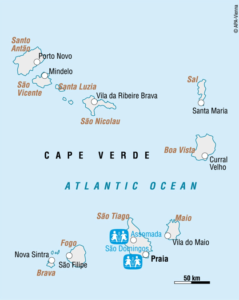Cabo Verde
Cabo Verde is located in the Atlantic Ocean, some 600 km off the west coast of Africa, facing Mauritania and Senegal. It has a surface area of just over 4,000 km². This archipelago is under constant threat from drought, leading to a major rural exodus. Lacking natural resources and fresh water, Cabo Verde’s agricultural activity is limited by the infertility of the land (only 10% is arable). Hillside farming has also led to serious soil erosion. In recent years, the islands have faced several crises that severely impacted the socio-economic situation: the eruption of the Pico do Fogo volcano (late 2014), Hurricane Fred (summer 2015), the Zika epidemic (2015-2016), and the Covid-19 crisis (since 2020).
Deprived of natural resources and marked by a lack of infrastructure, the country has struggled for a long time to expand its businesses and boost private investment. It remains dependent on imports (energy and food), European Union aid, funding sent by the diaspora (around 16% of its GDP in 2021), and development aid (13%). Cabo Verde has a very high emigration rate. Some 800,000 Cape Verdeans live abroad, while only 583,000 live in the archipelago, half of them on the island of Santiago. For years, the country has been relying on tourism (a quarter of national wealth) and has undertaken a series of reforms to boost the private sector and attract foreign investors. In 2008, Cabo Verde became a medium-development country. According to the UNDP’s HDI 2020 (Human Development Index), Cabo Verde ranks 126th out of 189 countries/territories. It is pursuing its development and improving its performance.
In this country, where 60% of the population is under the age of 30, the family structure is characterised by the absence of fathers, and there are a large number of unplanned births. Many mothers try to support their often large families on their own. Poverty increases the vulnerability of children, many of whom, particularly girls, often drop out of school and work (in agriculture, domestic service, or street vending) to support the family, if they are not left to fend for themselves on the streets. While significant progress has been made in education, with a net primary school enrolment rate of 98% (free and mandatory primary education has been universal since 2001) and an adult literacy rate of 85%, school drop-out rates remain high (over 10% in rural areas).
Cabo Verde ratified the United Nations Convention on the Rights of the Child on 4 June 1992. Measures have been taken to improve the situation in terms of children’s survival and development, but much remains to be done to protect their rights. In particular, child labour remains a problem (affecting more than 6% of 5 to 14-year-olds) in this country, which also ratified the Worst Forms of Child Labour Convention (C182, International Labour Organisation, 1999) in 2001 and the Minimum Age Convention (C138, ILO, 1973), set at 15, in 2011.

SOS, which conducts extensive advocacy work in defence of children’s rights, currently helps more than 2,000 beneficiaries (including 739 children and young people who are direct beneficiaries) through 2 children’s villages, 2 youth hostels, 1 social centre, 1 school (now under the aegis of the national education authority) and 1 employment and training programme. The association is increasing the number of public and private partnerships. It aims to change the mindset when it comes to family planning and to raise awareness among public authorities of the importance of developing social policies.